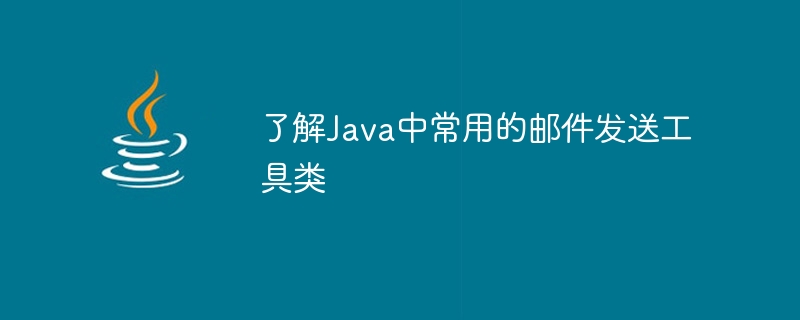Home >Java >javaTutorial >Learn common Java email sending tool classes
Learn common Java email sending tool classes
- 王林Original
- 2023-12-27 08:30:001362browse

Understand the commonly used email sending tools in Java
With the development of information technology, email has become an important way of communication and is widely used in various fields. kind of scene. In Java development, sending emails is a common requirement. In order to simplify the development process and improve development efficiency, we can use the email sending tool class in Java.
There are many excellent open source frameworks in Java that can implement email sending functions. The most commonly used ones include JavaMail and the JavaMail module in the Spring Framework. This article will introduce how to use these two email sending tool classes and some common application scenarios.
- JavaMail
JavaMail is a standard specification belonging to JavaEE that provides a set of APIs for sending and receiving emails. Using JavaMail to send emails requires the following steps:
- Add dependencies: In the pom.xml file of the Maven project, add the following dependencies:
<dependency>
<groupId>javax.mail</groupId>
<artifactId>javax.mail-api</artifactId>
<version>1.6.1</version>
</dependency>
<dependency>
<groupId>com.sun.mail</groupId>
<artifactId>javax.mail</artifactId>
<version>1.6.1</version>
</dependency>- Configure the mail server Information: When creating a JavaMail Session object, you need to configure the mail server information, including host name, port, protocol, etc.
String host = "smtp.example.com";
int port = 587;
String protocol = "smtp";
String username = "your_username";
String password = "your_password";
Properties props = new Properties();
props.put("mail.smtp.auth", "true");
props.put("mail.smtp.starttls.enable", "true");
props.put("mail.smtp.host", host);
props.put("mail.smtp.port", port);
Session session = Session.getDefaultInstance(props, new Authenticator() {
protected PasswordAuthentication getPasswordAuthentication() {
return new PasswordAuthentication(username, password);
}
});- Create a mail object: Use the Message class to create a mail object and set the sender, recipient, subject, body and other information.
Message message = new MimeMessage(session);
message.setFrom(new InternetAddress("from@example.com"));
message.setRecipients(Message.RecipientType.TO, InternetAddress.parse("to@example.com"));
message.setSubject("Hello");
message.setText("This is a test email.");- Send an email: Call the send method of the Transport class to send an email.
Transport.send(message);
Through the above steps, you can realize the function of sending emails using JavaMail.
The advantage of JavaMail lies in its stability and scalability. It can support multiple protocols and security configurations, and is suitable for various complex email sending scenarios. However, the use of JavaMail is relatively complicated and requires manual configuration of mail server information, which may be too cumbersome for some simple email sending needs.
- JavaMail module in Spring Framework
Spring Framework is an open source Java framework that provides many infrastructure and common functions for developing applications. Among them, the JavaMail module of the Spring Framework encapsulates the JavaMail API, simplifying the configuration and usage process of email sending. It can be easily integrated into Spring applications through the dependency injection mechanism of the Spring Framework.
Using the JavaMail module in Spring Framework to send emails requires the following steps:
- Add dependencies: In the pom.xml file of the Maven project, add the following dependencies:
<dependency>
<groupId>org.springframework.boot</groupId>
<artifactId>spring-boot-starter-mail</artifactId>
</dependency>- Configure mail server information: In the configuration file of the Spring application, configure the mail server information.
spring:
mail:
host: smtp.example.com
port: 587
username: your_username
password: your_password
properties:
mail:
smtp:
auth: true
starttls:
enable: true- Create a mail object: define a MailSender implementation class and use the @Autowired annotation to inject the mail sending function.
@Component
public class MyMailSender implements MailSender {
@Autowired
private JavaMailSender javaMailSender;
@Override
public void sendMail(MailMessage mailMessage) {
SimpleMailMessage message = new SimpleMailMessage();
message.setFrom(mailMessage.getFrom());
message.setTo(mailMessage.getTo());
message.setSubject(mailMessage.getSubject());
message.setText(mailMessage.getText());
javaMailSender.send(message);
}
}- Send mail: Call the sendMail method of MailSender to send mail.
@Component
public class MyMailClient {
@Autowired
private MailSender mailSender;
public void sendEmail() {
MailMessage mailMessage = new MailMessage();
mailMessage.setFrom("from@example.com");
mailMessage.setTo("to@example.com");
mailMessage.setSubject("Hello");
mailMessage.setText("This is a test email.");
mailSender.sendMail(mailMessage);
}
}By using the JavaMail module in Spring Framework, you can simplify the configuration and usage process of email sending and improve development efficiency.
Summary:
Commonly used email sending tool classes in Java include JavaMail and the JavaMail module in Spring Framework. JavaMail is a standard specification with good stability and scalability, and is suitable for complex email sending scenarios; Spring Framework's JavaMail module encapsulates the JavaMail API, simplifying the configuration and usage process, and is suitable for simple email sending needs. Depending on the actual needs and the complexity of the development environment, you can choose a suitable tool class to implement the email sending function.
The above is the detailed content of Learn common Java email sending tool classes. For more information, please follow other related articles on the PHP Chinese website!

